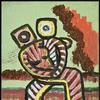Ayşin Yoltar-Yıldırım Appointed Curator of Islamic and Later Indian Art at the Harvard Art Museums
- CAMBRIDGE, Massachusetts
- /
- September 08, 2022

Martha Tedeschi, the Elizabeth and John Moors Cabot Director of the Harvard Art Museums, announced today the appointment of Ayşin Yoltar-Yıldırım as the new Norma Jean Calderwood Curator of Islamic and Later Indian Art at the Harvard Art Museums, effective October 3, 2022.
Currently the Hagop Kevorkian Associate Curator of Islamic Art at the Brooklyn Museum, in New York, Yoltar-Yıldırım has worked since August 2017 to organize the extensive reinstallation of the Brooklyn Museum’s Arts of the Islamic World galleries, which after being closed for a decade are slated to reopen on September 30, 2022. She also curated the 2018–19 exhibition Syria, Then and Now: Stories from Refugees a Century Apart.
Earlier in her career, Yoltar-Yıldırım held curatorial, research, and teaching positions as well as fellowships at several institutions in her native Turkey and the United States, including with the Aga Khan Program for Islamic Architecture at Harvard University, The Barakat Trust, and The Metropolitan Museum of Art in New York. She has presented at multiple conferences and taught courses on Islamic art throughout the United States and in Turkey. She is the author of the handbook Ottoman Decorative Arts, as well as several articles on Islamic arts of the book and the history of Islamic collections.
Yoltar-Yıldırım received a B.A. in art history and archaeology at Hacettepe University in Ankara, Turkey, in 1991 and an M.A. and Ph.D. in art history at the Institute of Fine Arts at New York University in 1994 and 2002, respectively.
Yoltar-Yıldırım returns to the Harvard Art Museums after having served as the Assistant Curator for Islamic and Later Indian Art from 2013 to 2017, and prior to that, the 2011–13 Norma Jean Calderwood Curatorial Fellow. During her time as a fellow, she assisted in the planning and installation of the 2013 exhibition In Harmony: The Norma Jean Calderwood Collection of Islamic Art and contributed entries to the accompanying catalogue. As an assistant curator she took part in the preparation and installation of the new Islamic and Later Indian art galleries, which opened as part of the renovated and expanded Harvard Art Museums facility in Fall 2014. She also organized the 2017 exhibition A New Light on Bernard Berenson: Persian Paintings from Villa I Tatti, after which she edited and contributed to the 2021 publication Persian Manuscripts & Paintings from the Berenson Collection.
In her new role at the Harvard Art Museums, Yoltar-Yıldırım will join the Division of Asian and Mediterranean Art and oversee the museums’ collection of Islamic and South Asian art. She will participate in a museum-wide rethinking and reframing of the museums’ permanent collections galleries and will develop future special exhibitions dedicated to the art of the Islamic regions and South Asia. She will collaborate with colleagues across the museums and campus to acquire new objects to diversify the holdings. She will also work closely with students and faculty to expand use of the collection in undergraduate and graduate teaching across disciplines; she will mentor students and curatorial fellows, training and nurturing the next generation in her field.
“We could not be more excited to welcome Ayşin back to the Harvard Art Museums, and we look forward to working with her on shaping an institutional vision that promotes a more inclusive and expansive cultural space,” said director Martha Tedeschi.
“I am thrilled to be coming back to the Harvard Art Museums and look forward to activating the Islamic and South Asian collection in new ways,” said Yoltar-Yıldırım.
The Harvard Art Museums’ collection of Islamic and South Asian art comprises devotional and secular works in a wide range of media made primarily by peoples living in Western, Central, and South Asia and around the Mediterranean from the early seventh century to the present day. Objects from Turkey, Iran, and India are especially well represented. Persian paintings, drawings, and calligraphy are a particular strength, as is Rajasthani painting. Ceramics, textiles, metalwork, and objects of other materials demonstrate a strong command of artistry and technique as well as rich cross-cultural exchanges. The majority of these objects are ceramic tiles and vessels from Islamic regions, but there are notable holdings of lacquer from Iran, pile carpets and Ottoman luxury silks, medieval and early modern metalwork, and coins. A cross-divisional initiative has added photographs from South Asia.















